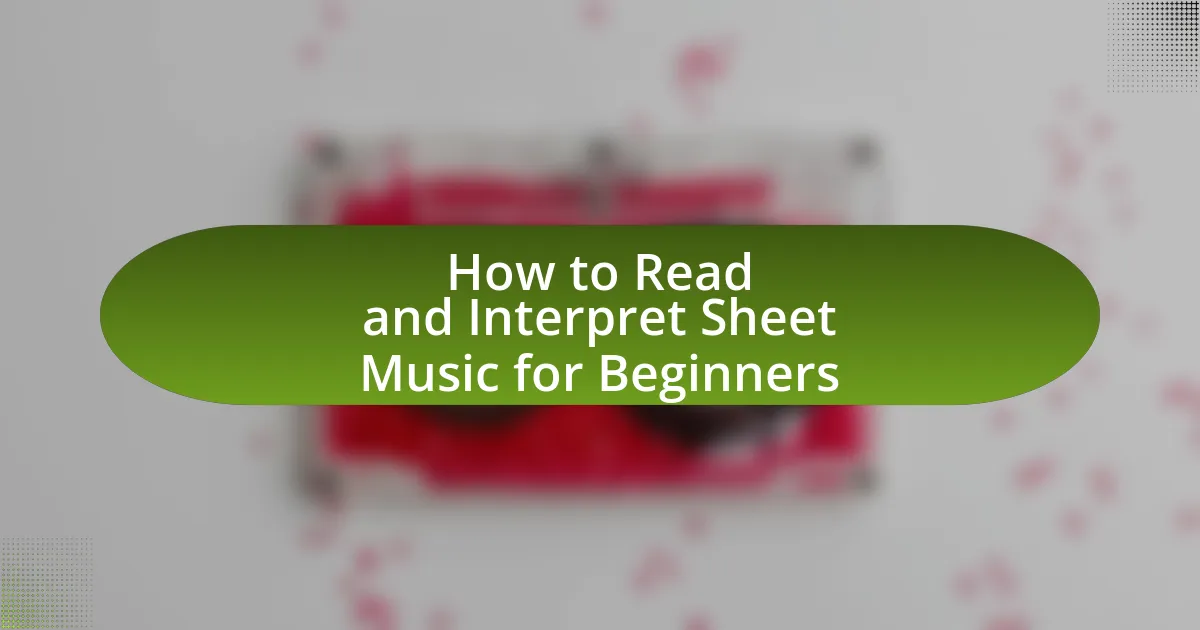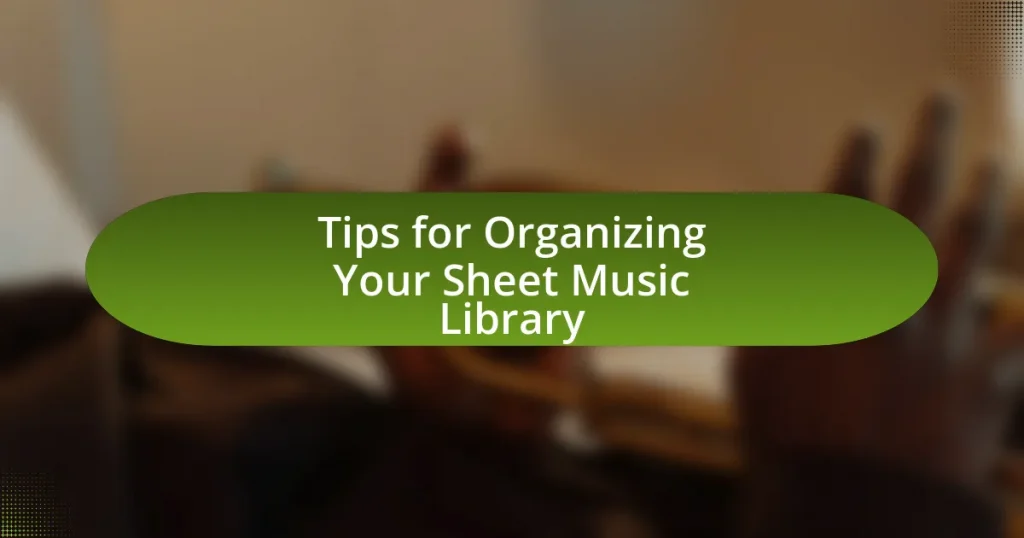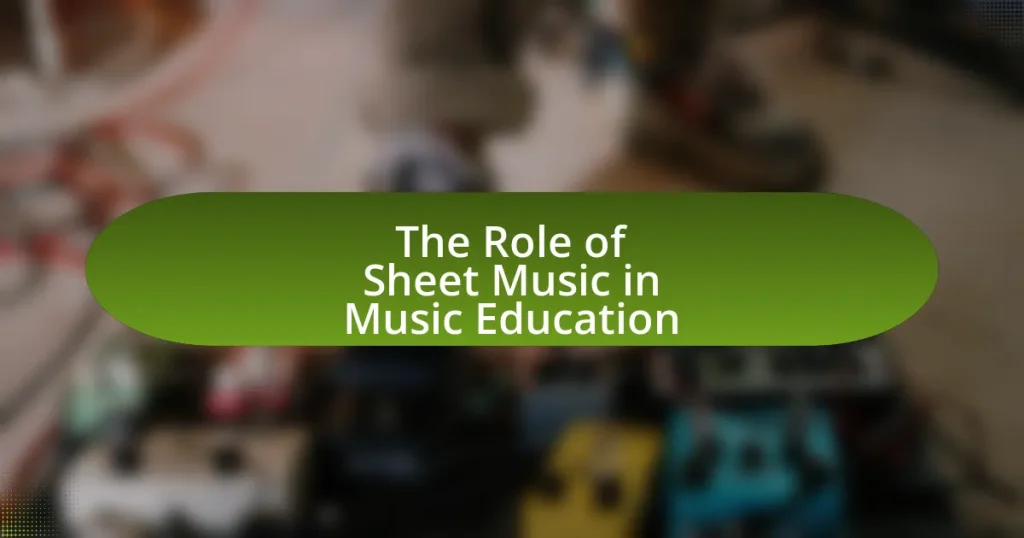Sheet music is a written representation of music that uses symbols to convey pitch, rhythm, and dynamics, making it essential for beginners learning to play instruments or sing. The article outlines the structure of sheet music, including staff lines, clefs, time signatures, and key signatures, and explains the significance of notes, rests, dynamics, and articulations in performance. It provides practical guidance for beginners on how to start reading sheet music, develop sight-reading skills, and utilize various resources, including books, online courses, and apps, to enhance their learning experience. Additionally, the article addresses common challenges faced by beginners and offers strategies to overcome them, ensuring a comprehensive understanding of how to read and interpret sheet music effectively.
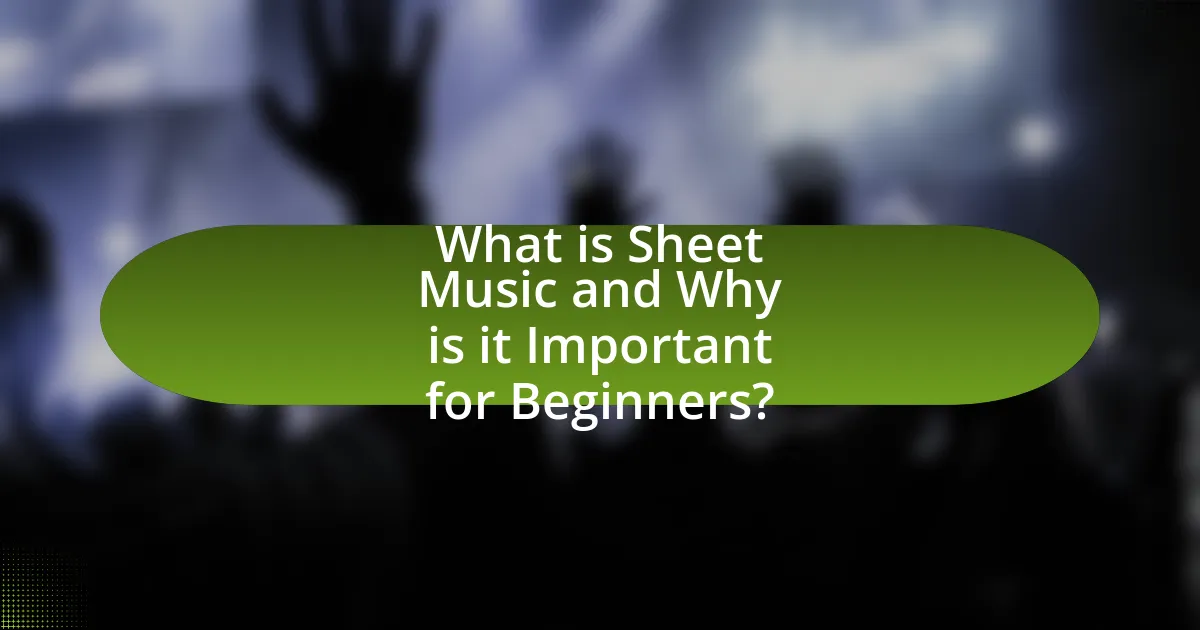
What is Sheet Music and Why is it Important for Beginners?
Sheet music is a written representation of music that uses symbols to indicate pitch, rhythm, and dynamics. It is important for beginners because it provides a structured way to learn and understand musical concepts, enabling them to play instruments or sing accurately. By reading sheet music, beginners can develop essential skills such as sight-reading, which enhances their ability to learn new pieces quickly. Additionally, sheet music serves as a universal language among musicians, facilitating collaboration and communication.
How is Sheet Music Structured?
Sheet music is structured using a combination of staff lines, notes, clefs, time signatures, and key signatures. The staff consists of five horizontal lines and four spaces, where notes are placed to indicate pitch. Clefs, such as treble and bass, define the pitch range of the notes on the staff. Time signatures, located at the beginning of a piece, indicate the number of beats per measure and the note value that receives one beat. Key signatures, found at the beginning of the staff, indicate the key of the piece by specifying which notes are sharp or flat throughout the music. This systematic arrangement allows musicians to read and interpret the music accurately.
What are the different parts of a sheet music score?
A sheet music score consists of several key parts: the staff, clefs, notes, rests, time signatures, key signatures, dynamics, and articulations. The staff is a set of five horizontal lines that represent different pitches. Clefs, such as treble and bass, indicate the pitch range for the notes on the staff. Notes represent musical sounds, while rests indicate silence. Time signatures specify the number of beats in a measure, and key signatures denote the key of the piece by indicating which notes are sharp or flat. Dynamics indicate the volume of the music, and articulations provide instructions on how to play the notes, such as staccato or legato. Each of these components plays a crucial role in conveying the musical information necessary for performance.
How do clefs and staffs function in sheet music?
Clefs and staffs are essential components of sheet music that organize musical notation. The staff consists of five horizontal lines and four spaces, each representing different pitches. Clefs, such as the treble and bass clef, are symbols placed at the beginning of the staff to indicate which notes correspond to which lines and spaces. For example, the treble clef assigns the note G to the second line, while the bass clef assigns the note F to the second line. This system allows musicians to read and interpret music accurately, facilitating communication of musical ideas.
What Symbols and Notations are Commonly Used in Sheet Music?
Common symbols and notations used in sheet music include the staff, clefs, notes, rests, time signatures, and key signatures. The staff consists of five lines and four spaces where notes are placed, while clefs, such as the treble and bass clefs, indicate the pitch range. Notes represent musical sounds, with different shapes and placements indicating duration and pitch, while rests signify silence for specific durations. Time signatures, located at the beginning of a piece, dictate the number of beats per measure and the note value that receives one beat. Key signatures, found at the beginning of the staff, indicate the key of the piece by showing which notes are sharp or flat. These elements are foundational for reading and interpreting music accurately.
What do notes and rests signify in sheet music?
Notes in sheet music signify specific pitches and durations that musicians are to play, while rests indicate periods of silence within the music. Each note corresponds to a particular frequency, and its shape and position on the staff determine its pitch and length. For example, a quarter note represents one beat, while a whole note represents four beats. Rests, such as a quarter rest or whole rest, similarly denote the length of silence that matches the duration of the corresponding notes. This system of notation allows musicians to understand both the sounds to produce and the pauses to observe, facilitating accurate performance of the piece.
How do dynamics and articulations affect performance?
Dynamics and articulations significantly influence performance by shaping the expressiveness and emotional impact of the music. Dynamics, which refer to the volume of sound, guide performers on how loudly or softly to play, affecting the overall intensity and mood of the piece. For instance, a crescendo builds excitement, while a decrescendo can create a sense of calm or resolution. Articulations, such as staccato or legato, dictate the style of note execution, impacting the clarity and flow of the music. Research indicates that performers who adhere to dynamic markings and articulations enhance listener engagement and convey the composer’s intent more effectively, as demonstrated in studies on musical interpretation and audience perception.
How Can Beginners Start Reading Sheet Music?
Beginners can start reading sheet music by familiarizing themselves with the staff, which consists of five lines and four spaces representing different musical pitches. Each line and space corresponds to a specific note, with the treble clef indicating higher pitches and the bass clef indicating lower pitches. Understanding the basic note values, such as whole notes, half notes, and quarter notes, is essential for grasping rhythm. Additionally, beginners should practice identifying notes on the staff and associating them with their corresponding keys on an instrument, such as a piano. This foundational knowledge is supported by music education resources, which emphasize the importance of consistent practice and gradual progression in learning to read music effectively.
What are the first steps to take when learning to read sheet music?
The first steps to take when learning to read sheet music include familiarizing oneself with the staff, understanding the notes, and recognizing the clefs. The staff consists of five lines and four spaces where notes are placed, and each line and space represents a different musical pitch. Understanding the notes involves learning their names and values, such as whole notes, half notes, and quarter notes, which dictate the duration of each sound. Recognizing the clefs, primarily the treble and bass clefs, is essential as they indicate the pitch range for the notes on the staff. These foundational elements are critical for beginners to effectively interpret and perform music.
How can beginners practice reading sheet music effectively?
Beginners can practice reading sheet music effectively by using a combination of consistent practice, visual aids, and interactive tools. Regularly dedicating time to sight-reading exercises helps reinforce note recognition and rhythm understanding. Utilizing visual aids, such as flashcards for note names and positions on the staff, enhances memory retention. Additionally, interactive tools like music apps and online tutorials provide engaging ways to learn and apply reading skills. Research indicates that structured practice routines significantly improve music reading abilities, as evidenced by studies showing that consistent exposure to sheet music leads to faster recognition and better performance outcomes.
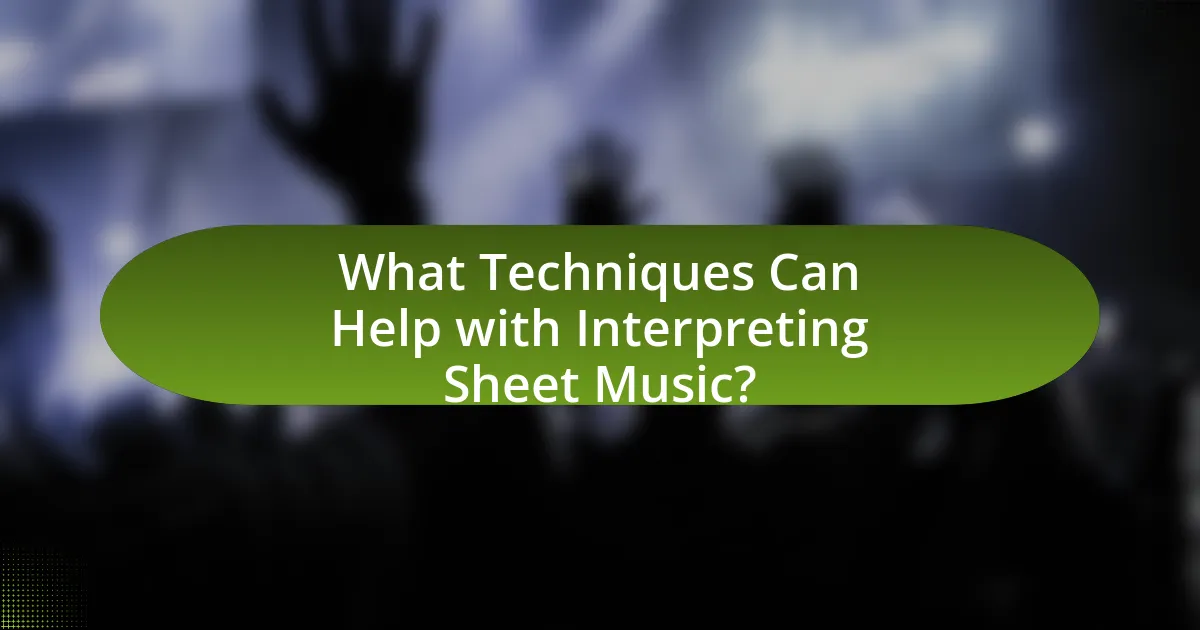
What Techniques Can Help with Interpreting Sheet Music?
Techniques that can help with interpreting sheet music include sight-reading, understanding musical notation, and practicing with a metronome. Sight-reading enhances the ability to read music quickly and accurately, which is essential for beginners. Understanding musical notation, such as notes, rests, dynamics, and articulations, provides the foundational knowledge necessary for interpreting the music correctly. Practicing with a metronome helps develop timing and rhythm, ensuring that the music is played as intended. These techniques are supported by educational resources that emphasize their importance in music learning, such as the “Music Theory for Dummies” guide, which outlines effective methods for beginners to improve their music reading skills.
How do Beginners Develop Musical Sight-Reading Skills?
Beginners develop musical sight-reading skills through consistent practice, exposure to various musical pieces, and the use of structured exercises. Regularly reading new music helps beginners familiarize themselves with different rhythms, notes, and musical symbols, enhancing their ability to recognize patterns quickly. Research indicates that sight-reading proficiency improves with targeted exercises, such as playing simple melodies and gradually increasing complexity, which reinforces the connection between visual notation and auditory perception. Additionally, utilizing methods like the “sight-singing” approach, where beginners sing the notes before playing them, can further solidify their understanding of pitch and rhythm, leading to improved sight-reading capabilities.
What exercises can improve sight-reading abilities?
Practicing scales and arpeggios can significantly improve sight-reading abilities. These exercises help musicians familiarize themselves with note patterns and finger placements, enhancing their ability to read music quickly. Additionally, sight-reading specific exercises, such as playing short pieces or excerpts at a steady tempo without stopping, reinforces the skill of reading ahead and maintaining rhythm. Research indicates that consistent practice of these exercises leads to improved fluency and accuracy in sight-reading, as evidenced by studies showing that musicians who engage in regular sight-reading practice demonstrate better overall reading skills compared to those who do not.
How does rhythm play a role in sight-reading?
Rhythm is crucial in sight-reading as it provides the temporal structure that guides musicians in timing their notes accurately. When sight-reading, musicians must quickly interpret rhythmic values, which dictate how long each note is held and when to play them in relation to one another. This understanding of rhythm allows for a cohesive performance, ensuring that the music flows as intended by the composer. Studies in music education highlight that proficient sight-readers demonstrate a strong grasp of rhythmic patterns, enabling them to anticipate and execute musical phrases effectively.
What Strategies Can Assist in Understanding Musical Context?
To understand musical context, one effective strategy is to analyze the historical and cultural background of the piece. This involves researching the composer’s life, the era in which the music was created, and the societal influences at that time. For instance, understanding that Beethoven composed during the transition from the Classical to the Romantic period can provide insights into the emotional depth and structural innovations in his works. Additionally, listening to various interpretations of the piece can enhance comprehension of its expressive qualities and stylistic nuances. Engaging with music theory concepts, such as harmony, rhythm, and form, also aids in grasping how these elements contribute to the overall context of the music.
How can dynamics and tempo influence interpretation?
Dynamics and tempo significantly influence interpretation by shaping the emotional and expressive qualities of a musical piece. Dynamics, which refer to the volume of sound, can convey intensity or softness, affecting how a listener perceives the mood. For example, a sudden crescendo can create excitement, while a decrescendo may evoke calmness. Tempo, the speed at which a piece is played, also alters interpretation; a fast tempo can generate urgency, while a slow tempo can instill a sense of reflection. Research indicates that performers who manipulate dynamics and tempo effectively can enhance the emotional impact of their interpretation, as evidenced by studies showing that variations in these elements lead to different listener responses.
What role does phrasing play in musical expression?
Phrasing plays a crucial role in musical expression by shaping the interpretation and emotional delivery of a piece. It involves the way musicians group notes and rhythms to create musical sentences, influencing dynamics, articulation, and timing. Effective phrasing allows performers to convey feelings and intentions, making the music more engaging and relatable to the audience. For instance, a well-phrased melody can evoke specific emotions, as seen in classical compositions where phrases often align with lyrical content, enhancing the overall impact of the performance.
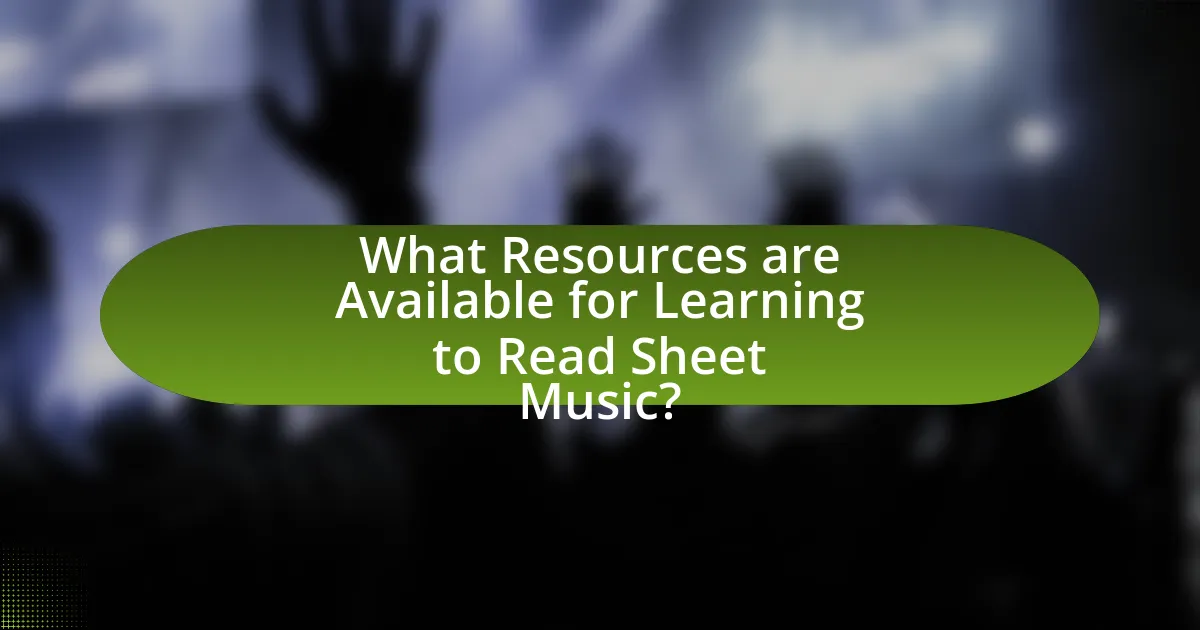
What Resources are Available for Learning to Read Sheet Music?
Various resources are available for learning to read sheet music, including online courses, instructional books, mobile apps, and video tutorials. Online platforms like Coursera and Udemy offer structured courses that cover the fundamentals of music notation and reading. Instructional books such as “How to Read Music” by A. J. G. McGowan provide step-by-step guidance and exercises. Mobile apps like Yousician and Simply Piano offer interactive learning experiences, allowing users to practice reading music in real-time. Additionally, YouTube hosts numerous video tutorials that visually demonstrate music reading techniques, catering to different learning styles. These resources collectively support beginners in developing their sheet music reading skills effectively.
What Books and Online Courses are Recommended for Beginners?
For beginners learning to read and interpret sheet music, recommended books include “How to Read Music in 30 Days” by Matthew Ellul and “The Complete Music Reading Trainer” by Andrew Mark. These books provide structured approaches to understanding musical notation and theory.
Online courses such as “Music Theory Fundamentals” on Coursera and “Reading Music for Beginners” on Udemy offer interactive lessons and practical exercises, enhancing the learning experience. These resources are widely recognized for their effectiveness in teaching foundational music reading skills.
Which websites offer interactive sheet music learning tools?
Websites that offer interactive sheet music learning tools include MuseScore, SmartMusic, and Noteflight. MuseScore provides a platform for users to create, share, and learn music with interactive scores and playback features. SmartMusic offers a subscription-based service that includes a vast library of interactive sheet music along with practice tools and feedback. Noteflight allows users to compose, share, and learn music interactively, featuring tools for playback and notation. These platforms are widely recognized for their educational resources and user-friendly interfaces, making them effective for beginners learning to read and interpret sheet music.
How can apps assist in learning to read sheet music?
Apps can assist in learning to read sheet music by providing interactive tools and resources that enhance understanding and retention. These applications often include features such as visual aids, audio playback, and gamified learning experiences that engage users. For instance, apps like MuseScore and Simply Piano allow users to practice reading notes in real-time, offering instant feedback on their performance. Research indicates that interactive learning tools can improve music literacy skills significantly, as they cater to various learning styles and provide a hands-on approach to mastering sheet music.
What Tips Can Help Beginners Overcome Challenges in Reading Sheet Music?
To help beginners overcome challenges in reading sheet music, it is essential to practice regularly, as consistent practice reinforces recognition of notes and symbols. Beginners should start by familiarizing themselves with the staff, clefs, and note values, which form the foundation of reading music. Utilizing mnemonic devices can aid in memorizing the lines and spaces of the staff, such as “Every Good Boy Does Fine” for the treble clef lines. Additionally, breaking down pieces into smaller sections allows for focused practice, making it easier to master complex passages. Engaging with interactive tools, such as apps or online tutorials, can provide immediate feedback and enhance learning. Research indicates that structured practice and the use of technology significantly improve music reading skills among beginners.
How can beginners stay motivated while learning?
Beginners can stay motivated while learning by setting clear, achievable goals and tracking their progress. Establishing specific milestones, such as mastering a particular piece of music or understanding a new notation, provides a sense of accomplishment. Research indicates that goal-setting enhances motivation and performance, as outlined in the study by Locke and Latham (2002), which found that specific and challenging goals lead to higher performance levels. Additionally, incorporating regular practice sessions and rewarding oneself for reaching these goals can further reinforce motivation.
What common mistakes should beginners avoid when reading sheet music?
Beginners should avoid several common mistakes when reading sheet music, including neglecting to understand the staff and clefs, misinterpreting note values, and failing to recognize key signatures. Understanding the staff and clefs is crucial, as they indicate the pitch of notes; for example, the treble clef signifies higher pitches while the bass clef indicates lower ones. Misinterpreting note values can lead to incorrect timing; beginners often confuse whole notes, half notes, and quarter notes, which can disrupt rhythm. Additionally, failing to recognize key signatures can result in playing incorrect notes, as key signatures dictate which notes are sharp or flat throughout a piece. These foundational elements are essential for accurate music reading and performance.
